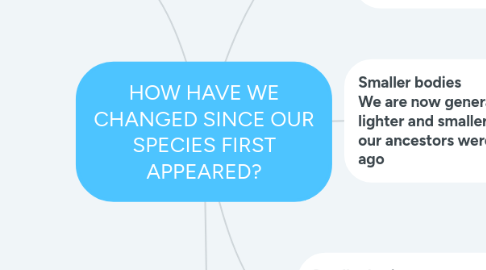HOW HAVE WE CHANGED SINCE OUR SPECIES FIRST APPEARED?
by Pedro Corona


1. Smaller teeth and jaws The trend toward smaller jaws and teeth that was seen in our ancestors has continued in our own species. In fact, some people today do not have enough space in their jaws to fit their 3rd molars or wisdom teeth
1.1. Overall, these changes have occurred in proportion with a decrease in body size. However, over the last 10,000 years dietary changes and technology have played a major role.
2. All one species – how climate affects physical characteristics
2.1. Body builds: Short, stocky builds are typical of humans living in cold climates.
2.2. Skin colour: Lighter skin allows the penetration of the sun’s UV rays. These rays help the body to synthesise vitamin D
2.3. Noses: People living in hot, humid climates tend to have broad, flat noses that allow inhaled air to be moistened and the moisture in exhaled air to be retained.
2.4. Hair: Tight, curly hair keeps the hair off the neck and exposes more areas of the scalp than straight hair.
2.5. Face shape: Eskimos have adapted to extreme cold by retaining layers of fat on their faces for additional warmth.
2.6. Mouth shape: Thick lips have a larger surface area to help evaporate moisture and cool the body.
2.7. Eyes: The epicanthic fold common among Northern and Eastern Asian populations is an adaptation for protecting the eye from the hard driving snow typical in these regions, and also to reduce snow glare.
2.8. Australian Aborigines of the Central Desert have an unusual physical adaptation to living in a climate where it can be freezing for short periods, such as during cold desert nights
3. Physical and genetic characteristics in response to varying climates and lifestyles interactions between genetics environment and lifestyle practices such as diet and technology
4. Smaller bodies We are now generally shorter, lighter and smaller boned than our ancestors were 100,000 years ago
4.1. 40,000 years ago: European males – 183 cm (6 feet).
4.1.1. 10,000 years ago: European males – 162.5cm (5 ft 4 inches)
